MGB – To B or not to B?
Chapter 4
![]()

MGB gearbox with Overdrive
The gearbox was upgraded in the MGB; it started life as a basic three-synchro gearbox with an optional overdrive unit which gave the car a much- needed 5th gear. This progressed to a four-synchro overdrive gearbox in late 1967 when the MK2 car appeared. It was a significant improvement making the gearbox more pleasurable and easier to use for many.
The “crash first gear” as it was often referred to was gone, the driver could now engage first gear while moving without the inevitable crunching and grinding noise the three synchro boxes would give out to warn you that you should be stationary before attempting first gear. The overdrive gearbox was an added feature that effectively gave the user the 5th gear; it was a big help at higher cruising speeds and was beneficial to keep engine revs lower.
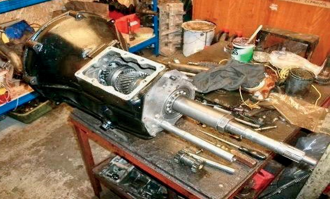
MGB Gearbox stripped showing internals
The gearbox was upgraded in the MGB; it started life as a basic three-synchro gearbox with an optional overdrive unit which gave the car a much- needed 5th gear. This progressed to a four-synchro overdrive gearbox in late 1967 when the MK2 car appeared. It was a significant improvement making the gearbox more pleasurable and easier to use for many.
The “crash first gear” as it was often referred to was gone, the driver could now engage first gear while moving without the inevitable crunching and grinding noise the three synchro boxes would give out to warn you that you should be stationary before attempting first gear. The overdrive gearbox was an added feature that effectively gave the user the 5th gear; it was a big help at higher cruising speeds and was beneficial to keep engine revs lower.
The first style of gearbox already mentioned was the three-synchro unit that had synchromesh on 2nd, 3rd, and 4th gears. The casing was made from aluminium and had a dipstick on the right-hand side of the gearbox to check and top up the oil level. The gear lever sat on the top extension; you will find that the early three-synchro model tunnels are shaped very differently at the top and moulded for this style of gearbox. On the top of the tunnel was a metal extension, that was bolted in place around the central section, with a gear lever that extended out and backwards, there was a small kick forward to bring it into a more natural position for the driver. The gear knob itself was a Bakelite item that was pear-shaped and had markings in white, so the user could find the way around the gearboxes standard H pattern for the forward gears with reverse over to the left and back. The main changes to mention on the three-synchro gearbox are the first motion shaft in October 1964, the input spigot was a larger size, increased from 0.62in up to 0.85in and the casing was modified too.
During 1963 the option to have a Laycock D-type overdrive unit was offered at an additional cost; the gearbox was a different design to accommodate the overdrive unit. The rear extension on the gearbox housing was shortened to make room for the overdrive; the gear lever was also changed to a single bend in the lever at the bottom. In late 1965 the second gear synchromesh was updated and in September 1966 a switch to activate the reverse lights was added.
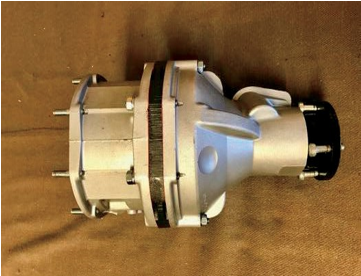
Laycock D-type overdrive unit image.
|
Gearbox Ratios and overall ratios for the three synchro models |
||
|
Gearbox ratio |
Overall ratio | |
| First gear | 3.6363:1 | 14.2142:1 |
| Second gear | 2.2143:1 | 8.6557:1 |
| Third gear | 1.3736:1 | 5.3694:1 |
| Fourth gear | 1.00:1 | 3.909:1 |
| Overdrive | 0.82:1 | 3.1350:1 |
| Reverse gear | 4.7552:1 | 18.5881:1 |
In late 1967 the original gearbox was replaced by a full synchromesh unit based on the MGC gearbox. This one was designed to handle the 150 bhp of the much larger three-litre engine of the MGC and was rather over-engineered when mated with the standard MGB B-Series engine. The same gearbox unit was also used in the 3.5-litre MGB-GT-V8. An automatic three-speed transmission was offered as a factory option but was not well received. Many thought it took the driving pleasure away from the car along with slowing things down with a very relaxed gear change and not the smoothest of auto gearboxes; the option was soon dropped as sales proved it was not popular enough to continue with.
MGB engine attached to gearbox and overdrive
The four synchromesh gearboxes appeared in the MK2 models on all GHN4 and GHD4 cars; the gears were housed in an all-new casing with closer ratios now being used. The four synchro gearbox was wider, so the gearbox tunnel in the body shell was also changed to allow this larger box to fit, a few inches of room was lost in the foot well, but that was worth it in exchange for the enhanced feel and quicker operation of the new gearbox. With the new tunnel also, came a change in the gear lever as the altered design allowed the lever to exit straight up and the bulge around the gear lever on the interior of the tunnel was gone leaving a smoother cleaner look.
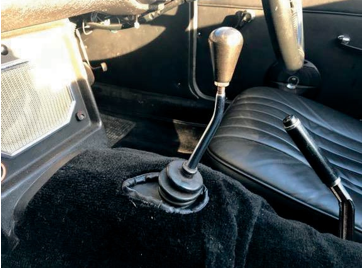
3 synchro gear lever with the original style pear drop gear knob, note the kink in the gear lever as all the early cars had.
| Gearbox Ratios for MK11 1967 – 1974 cars | ||
| Gearbox ratio | Overall ratio | |
| First gear | 3.440:1 | 13.446:1 |
| Second gear | 2.167:1 | 8.470:1 |
| Third gear | 1.382:1 | 5.402:1 |
| Fourth gear | 1.00:1 | 3.909:1 |
| Overdrive | 0.82:1 | 3.205:1 |
| Reverse gear | 3.095:1 | 12.098:1 |
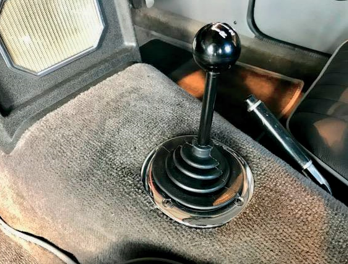
Gear lever for MK 2 version
Minimal changes occurred from the start of the four-synchro gearbox and the only real noticeable changes were the design of the gear knob and surrounding console design. The gear lever knob went to a golf ball-type design and again with white numbering showing the layout of the forward- reverse gears that remained in the same position on all gearboxes. This gear knob continued from 1967 until 1973; it was then replaced by a plastic-style padded item before finally going to the larger switch/gear knob operating the overdrive unit, this was definitely more convenient to use than the dashboard- mounted version but did not feel quite as nice in use.
| Gearbox Ratios for MK11 1967 – 1974 cars | ||
| Gearbox ratio | Overall ratio | |
| First gear | 3.440:1 | 13.446:1 |
| Second gear | 2.167:1 | 8.470:1 |
| Third gear | 1.382:1 | 5.402:1 |
| Fourth gear | 1.00:1 | 3.909:1 |
| Overdrive | 0.82:1 | 3.205:1 |
| Reverse gear | 3.095:1 | 12.098:1 |
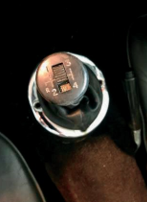
Minimal changes occurred from the start of the four-synchro gearbox and the only real noticeable changes were the design of the gear knob and surrounding console design. The gear lever knob went to a golf ball-type design and again with white numbering showing the layout of the forward- reverse gears that remained in the same position on all gearboxes. This gear knob continued from 1967 until 1973; it was then replaced by a plastic-style padded item before finally going to the larger switch/gear knob operating the overdrive unit, this was definitely more convenient to use than the dashboard- mounted version but did not feel quite as nice in use.
| Gearbox Ratios for 1974 – 1976 cars | ||
|
Gearbox ratio |
Overall ratio |
|
| First gear | 3.036:1 | 11.867:1 |
|
Second gear |
2.167:1 | 8.470:1 |
| Third gear | 1.382:1 | 5.402:1 |
|
Fourth gear |
1.00:1 | 3.909:1 |
| Overdrive | 0.82:1 | 3.205:1 |
|
Reverse gear |
3.095:1 | 12.098:1 |
Gear-lever from 1973-1977
The side casing of the gearbox had small revisions made for the start of the rubber bumper cars and was fitted with a filler plug instead of the dipstick; the speedo drive was changed which mandated a change of the speedo dial.
There were changes in the gearing as the rubber bumper cars had a slightly higher ratio on the first gear, this was altered in 1977.
| Gearbox Ratios for 1977 – 1980 cars | ||
|
Gearbox ratio |
Overall ratio | |
| First gear | 3.333:1 | 13.03:1 |
| Second gear | 2.167:1 | 8.470:1 |
| Third gear | 1.382:1 | 5.402:1 |
| Fourth gear | 1.00:1 | 3.909:1 |
| Overdrive | 0.82:1 | 3.205:1 |
| Reverse gear | 3.095:1 | 12.098:1 |
Electrically engaged overdrive gearboxes were an option on all MGBs from early 1963. The overdrive unit worked in third and fourth gears until 1977 when overdrive was only operational in fourth. The overall ratio in third-gear overdrive was almost the same as fourth-gear direct; so many did not see the benefit of using overdrive in 3rd gear. The new overdrive unit used a toggle switch on the dashboard, later moved to the wiper stalk in 1974 and then to the top of the gear knob in late 1976 where it stayed for the rest of the production run.
The overdrive gearbox made long-distance cruising more appealing. With the road network expanding, and more motorways being built, the MGB had to keep up, this made for a more comfortable and quieter, not forgetting more economical drive. Nowadays, to many drivers, the thought of flicking a switch to operate an extra gear is quite novel and an experience in itself. The ability to use the 5th
gear without even using the clutch pedal can feel very alien to anyone born after 1970. Today the traditional MGB still relies on this tried and tested method although there are several other options.
Five-speed gearboxes from the Ford Sierra and the Mazda MX5 are both available; they make the MGB experience even more comfortable, the latter because of smoother gear changes and closer ratios. One argument suggests this makes MGB ownership even more pleasurable while some might say it detracts from the original feel, either way, it keeps the MGB on today’s roads, where it belongs.
There were three different types of Overdrive fitted to the MGB.
Laycock Type D OD
1020 TPM for the OD and 1040 TPM for the non- OD
1968 to 1974
Laycock Type LH OD Rectangular-shaped access cover Oval clutch fork boot
Dipstick
A black label on the OD solenoid cover
Speedometer-driven gear that was white with 21 teeth
1974 to 1980
Export Roadster Production figures for the automatic gearbox.
Laycock Type LH OD Rectangular-shaped access cover Square clutch fork boot
Side fill plug (no dipstick)
Blue label on the OD solenoid cover Speedometer driven gear was red with 20 teeth
Automatic Gearbox
An automatic gearbox in a sports car I hear you cry, but MG did decide to offer a three-speed Borg- Warner type 35 gearbox to the line-up. Initially, this was likely to be aimed at the North American market but did not sell in any quantity, the automatic option only lasted from 1967 when it was first introduced until late 1973 and was the same box as offered in the MGC.
Automatic gearbox selector
The gears were selected by a neat-looking gear lever that worked its way through the auto selector where you could choose between Park, Reverse, Neutral, Drive, and Low 1 and Low 2.
In total, it is reported that just over 1700 MGBs were fitted with the automatic gearbox and the majority were GT models, and the records show that most of the auto cars stayed in the UK. The automatic option was never re-introduced into the line-up, and after driving several myself over the years I can see the appeal of the relaxed cruising driving style, but it just doesn’t get enough out of the engine and does take away some of the fun factors that an MGB gives. The figures below confirm that the MGB automatic option was not produced in large numbers, not that many survive today so is quite a rare machine. However, the lack of desirability for them has not done much for the value of the vehicle and they remain similar in price to a manual version.
| Production figures for the automatic gearbox | |
| Year – 1968 | |
| MGB GT home market cars | 74 |
| Export GT cars in RHD | 10 |
| Export GT cars in LHD | 2 |
| MGB Roadster home market cars | 12 |
| Export Roadster cars in RHD | 2 |
| Australia Roadster cars |
36 (CKD completely Knocked down) |
| Year 1969-1971 | |
| MGB GT home market cars | 475 |
| Export GT cars in RHD | 40 |
| Export GT cars in LHD | 30 |
| MGB Roadster home market cars | 90 |
| Export Roadster cars in RHD | 10 |
| Export Roadster in LHD | 7 |
| Australia Roadster | 192 (CKD) |
| Year 1972-1973 | |
| MGB GT home market cars | 603 |
| Export GT cars in RHD | 29 |
| Export GT cars in LHD | 22 |
| MGB Roadster home market cars | 92 |
| Export Roadster cars in RHD | 3 |
| Export Roadster cars in LHD | 6 |
